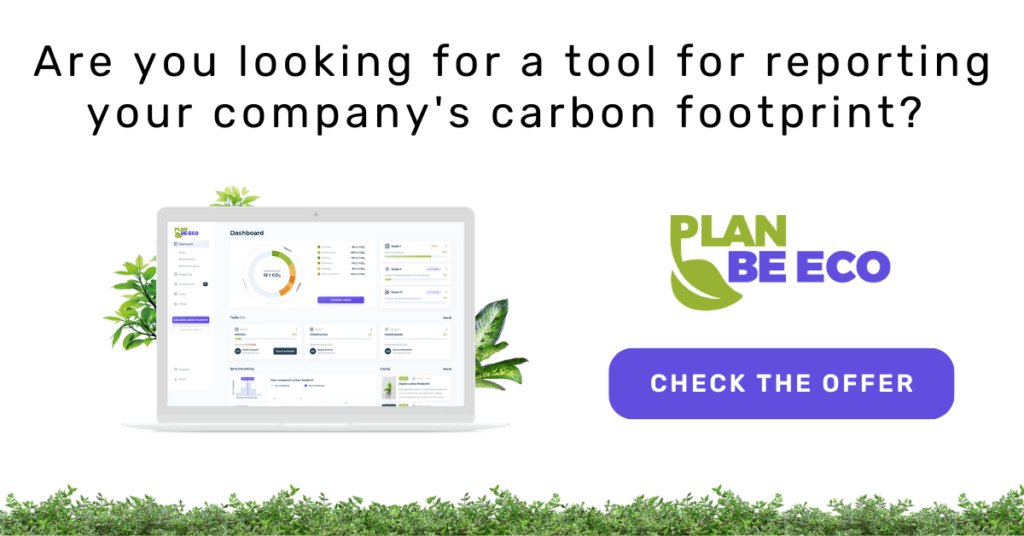Top 7 Best B2B Carbon Footprint Softwares in 2023 for Sustainable Business Management

With businesses facing increasing pressure to manage their environmental impact, the best b2b carbon footprint softwares in 2023 are a necessity, not a luxury. This article reviews top solutions that offer comprehensive emissions tracking, seamless integrations, and compliance with the latest regulatory standards. Discover how these tools can facilitate your sustainability journey, support decision-making, and position your company as an environmental leader.
Table of content
Key takeaways
- Carbon footprint software is essential for B2B companies to manage greenhouse gas emissions, comply with global standards, and meet the increasing demand for environmental responsibility among clients.
- Essential features of carbon accounting software should include integration capabilities, calculators for Scope 1, 2, and 3 emissions, real-time tracking, and compliance with regulatory reporting (Greenhouse gas Protocol) to effectively manage and report GHG emissions.
- The integration of carbon accounting into operational risk management helps businesses address financial and regulatory risks related to climate change, while AI technology automates emissions data verification for accuracy and compliance with industry standards.
Understanding carbon footprint in the B2B landscape

A company’s carbon footprint is a comprehensive measure that includes all greenhouse gases emissions both directly and indirectly through its activities, such as carbon dioxide emissions. These gases, including:
CO2
CH4
N2O
fluorinated gases
have varying environmental impacts, making their management critical to building sustainable business models. But it’s not just about sustainability. Companies are under pressure to meet growing client interest in environmental responsibility and comply with emerging global reporting standards. Investors and contractors are increasingly demanding carbon footprint reports from companies.
However, greenhouse gas accounting, particularly Scope 3 emissions, is no easy feat. Companies often face challenges due to data access limitations and inadequate internal reporting infrastructure. As a result, achieving a comprehensive and precise understanding of a company’s carbon footprint can prove challenging.
Essential features in B2B carbon calculating software

Several key features are crucial when choosing carbon accounting software. One such feature is integration capabilities, which allow for the seamless merging of emissions data from diverse sources into a coherent structure. This includes data from energy consumption and supply chain activities. Furthermore, a centralized data management system is crucial for tracking, analyzing, and reporting greenhouse gas (GHG) emissions data from various operational aspects of a business.
The key features of the software should include:
Ability to accurately calculate emissions by GHG Protocol methodology
Scope 3 emissions reporting across all categories
compliance with carbon footprint reporting standards
Detailed breakdown of emissions using emission factors and conversion factors, including global warming potential (GWP) factors of various GHGs.
Adaptability and ease of updating to accommodate new emission sources and reporting requirements as companies grow and expand
reliable metrics and accountability for updating them
identification of areas of savings
automated management of entered data
possibility to share the reporting process among a larger number of people in the tool
adaptation of the tool to the company structure (allocation of data between different sites)
individual approach to the supply chain
These features ensure the software’s effectiveness in managing emissions and meeting reporting requirements.
Leading carbon emissions accounting platforms for B2B companies
With the complex demands of emissions management and sustainability reporting, several leading carbon accounting solutions have emerged, tailored specifically for B2B companies. These solutions offer a variety of key features and personalized support that adhere to industry practices and regional guidelines, guaranteeing compliance and aiding in real-time sustainability decision-making. Among these solutions, the best carbon accounting practices can be identified.
Greenly
Greenly is a climate technology firm that provides distinctive software allowing small and medium-sized businesses to assess, diminish, and compensate for their carbon emissions in accordance with global carbon accounting norms like the GHG Protocol. Leveraging cutting-edge technology, Greenly facilitates carbon footprint management by seamlessly integrating with automatically gathered and analyzed data sources.
IBM Environmental Intelligence Suite
In today’s climate, companies are increasingly exposed to climate-related asset damage, supply chain disruptions, and operational challenges. IBM Environmental Intelligence Suite is a SaaS platform that supports monitoring, predicting, and responding to weather and climate impacts. It is not a carbon footprint calculator, however, with the following features:
Data management
Rudimentary climate risk analytics
AI capabilities to aid large companies in environmental management
Integration of advanced technology for predicting future climate scenarios
helps companies make informed decisions about environmental management.
Microsoft Sustainability Cloud
Microsoft Sustainability Cloud provides features like recording and reporting environmental impacts, tracking emissions, and dashboards to visualize emission activities. It achieves this through automated data analysis and actionable insights.
Designed to serve mid-market and customers, Microsoft Sustainability Cloud provides a solution that meets their specific sustainability management needs. ESG capabilities are a key feature of the platform, helping companies manage their environmental, social, and governance responsibilities.

Normative
Normative enables companies to calculate, report, and understand their full Scope 1, 2, and 3 carbon emissions. Normative’s carbon accounting engine relies on millions of data points to provide companies with actionable insight into emissions across their operations and value chain.
They provide continuous insight into emissions, enabling companies to foster innovation, minimize material and energy consumption, and develop credible marketing strategies. With this approach, companies can effectively address their sustainability challenges.
Plan A Earth
Plan A is a provider of 3-scope carbon accounting, decarbonization, and ESG reporting software. The software supports companies in achieving emission reduction targets while staying ahead of ESG and sustainability reporting standards.
The software automates carbon calculations and enables decarbonization planning, as well as ESG reporting. Plan A adheres to strict social and environmental standards.
Plan Be Eco
Plan Be Eco is a comprehensive carbon footprint calculation and reporting tool that makes it easy to meet ESG reporting requirements and supports the company’s commitment to climate neutrality. Using Plan Be Eco software is characterized by its low cost – which makes it accessible to different types of companies, as well as its ease of use – even people without special training can cope with completing GHG emissions data. The indicators that are implemented in Plan Be Eco come from verified databases, and the entire methodology complies with GHG Protocol requirements.
Plan Be Eco stands out from similar solutions:
carbon footprint reporting – all 3 scopes in all categories for each industry
automation in data collection
customized supply chain approach (depending on available data)
ability to share the process between those responsible in one company
allocation of data between locations, departments of the company
the structure of organizations and capital companies
Plan Be Eco software is positively evaluated by users, who find it a simple, intuitive, tailored, and effective tool to support emissions management. Entrepreneurs can calculate the carbon footprint of their supply chains in all three scopes.
Read the Plan Be Eco carbon footprint report for 2023.
Salesforce Net Zero Cloud
Among the leading solutions is Salesforce Net Zero Cloud, acknowledged for its:
Robust dashboard functionality, which enhances the user’s data visualization and management experience
Adept integration and analysis of environmental, social, and governance (ESG) data
Management of complex data schemas related to carbon, waste, and water across the value chain
Despite its advantages, feedback regarding Salesforce Net Zero Cloud’s scalability has been mixed. Some users have pointed out dependencies on pre-existing data schemas not originally intended for carbon accounting, posing potential limitations.
The role of industry partnerships in enhancing carbon accounting solutions
Collaborations within the industry are vital for advanced carbon accounting and significant emission reductions. Partnerships and standardization throughout value chains are necessary, as they demonstrate the software’s depth of industry knowledge and capability to support current and future emissions management strategies.
Significant proportions of supply chain emissions for large entities come from an expansive list of vendors, including small and midsize companies. This greatly influences their overall sustainability performance. Therefore, industry partnerships empower companies to rapidly address emissions across their entire value chain, tackling both upstream and downstream impacts.
For instance, the Carbon Transparency Partnership initiated by the World Business Council on Sustainable Development aims to enhance transparency in carbon accounting. Only through cooperation between organizations will we be able to reduce emissions globally – and only this will stop the further progress of climate change.
Integrating greenhouse gas emissions accounting into operational risk management
Integrating carbon accounting into operational risk management is vital for businesses to manage the financial, competitive, and regulatory hazards brought about by climate change. The financial industry is beginning to recognize carbon impact as the ‘new credit risk’, necessitating its inclusion in operational risk management frameworks.
Regulatory bodies like the OCC and FRB are incorporating carbon emission risk in their operational risk planning, signaling a shift towards accounting for climate change impacts in finance. Using data-driven approaches, businesses can assess carbon emission risk and integrate it into the overall enterprise risk framework, which is key for sectoral financing and exposure comprehension.
AI technology is being used within carbon management systems to automate the verification of emissions data in real-time against industry standards like the EPA’s system and GRI Standards. This ensures that the data collected is accurate, reliable, and adheres to reporting standards.
Learn tips for reducing carbon emissions
Tailoring Your Choice: Selecting the Right Carbon Accounting Software for Your Business
Selecting the best carbon accounting software for your business involves the consideration of several factors:
Time-efficient implementation
Seamless integration with legacy accounting systems
Scalability to minimize disruption in existing processes as the company grows
Cost-effectiveness
Strong customer support
Independent functionality that reduces reliance on consultants
By considering these factors, you can find a software solution that meets your business needs.
Additionally, effective carbon management software needs to:
Provide centralized data management
Cover all 3 emission scopes for comprehensive tracking and reporting of direct and indirect emissions
Be adaptable and easy to update to accommodate changes in business growth, needs, and operations without causing significant disruptions.
Beyond Compliance: How carbon footprint calculating software can drive business value

Carbon footprint calculating software can drive considerable business value, going beyond mere compliance. It aids companies in:
Identifying excessive energy usage and waste, leading to significant cost reductions
Prioritizing sustainability, which aligns with investor demands as most mainstream investors consider ESG criteria in their decisions
Demonstrating superior performance on capital markets for businesses with sustainable, low-carbon products, resulting in enhanced shareholder returns and growth.
Brand equity increases as consumers, employees, and investors increasingly value environmentally responsible and sustainable practices. The focus on sustainability helps companies avoid the risk of missing out on strategic business opportunities. Carbon accounting software not only supports achieving net zero emissions but also provides a distinct competitive advantage in the market.
For reliability in measuring and disclosing sustainability data, carbon accounting software is essential to business operations. It enhances operational efficiencies by identifying emission hotspots and integrating data systems for optimization, leading to focused emission reduction strategies in business processes.
User experience matters: Software with an easy-to-use interface
Carbon accounting software needs to have a user-friendly interface to ensure efficient navigation and use by employees, underscoring the importance of intuitive design in the adoption of such platforms. Complicated tools can hinder the widespread adoption of carbon accounting platforms, emphasizing the need for easy-to-use software to encourage team engagement in sustainability efforts.
A user-friendly design in carbon accounting software encourages broader engagement and participation, streamlining the process of managing a company’s emissions effectively. Designing for mobile-first solutions ensures that the interface is simple and effective even on smaller screens, contributing to the overall sustainability goals through reduced energy consumption.
The Plan Be Eco software received high praise for its user-friendly interface – entrepreneurs participating in the pilot pointed to its intuitive operation, simplicity in reporting data, and clear presentation of results.
From assessment to action: software that facilitates carbon reduction strategies
Carbon accounting software aids in strategic planning by:
Allowing the setting of realistic and measurable emission reduction targets
Aligning these targets with the global shift towards achieving net-zero emissions by 2050
Continuous monitoring through carbon accounting tools is essential for evaluating the effectiveness of sustainability initiatives
Adjusting strategies to meet environmental goals
Sector-specific carbon accounting platforms offer tailored advice and mitigation strategies, contributing to long-term sustainable solutions for businesses. As a leading carbon accounting platform, carbon accounting software enhances operational efficiencies by identifying emission hotspots and integrating data systems for optimization, leading to focused emission reduction strategies in business processes.
Summary
In the quest for sustainable business management, carbon accounting software has emerged as an essential tool. It helps businesses navigate the complexities of measuring, tracking, and reporting carbon emissions. But beyond compliance, it also drives business value by identifying inefficiencies, aligning with investor demands, and enhancing brand equity.
Choosing the right software requires considering several factors, including scalability, user-friendliness, and cost-effectiveness. With the right solution in place, businesses can effectively manage their carbon footprint, contribute to global sustainability efforts, and gain a competitive edge in the market.
Frequently Asked Questions
Which carbon offset program is best?
The one that is verified and reliable. However, reducing the carbon footprint is not about offsets, but effective emission reductions. Buying carbon credits (offsets) without first reducing carbon emissions is insufficient and even bears the hallmarks of greenwashing.
What is carbon accounting softwares?
Carbon footprint calculating software is a tool that helps businesses measure, track, and report their carbon emissions, enabling them to comply with emission reporting standards and drive sustainable business management.
What innovations are there in carbon tracking solutions?
Carbon management software has seen innovations such as AI-driven solutions and real-time emissions tracking, which enable businesses to forecast and collect emissions data more effectively. This can greatly improve carbon management efforts and environmental impact mitigation.
